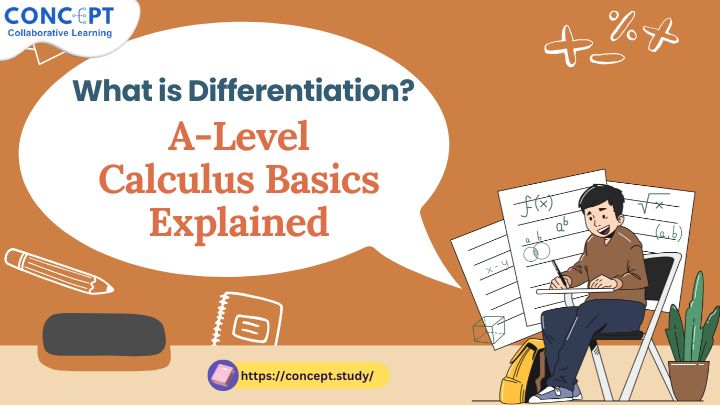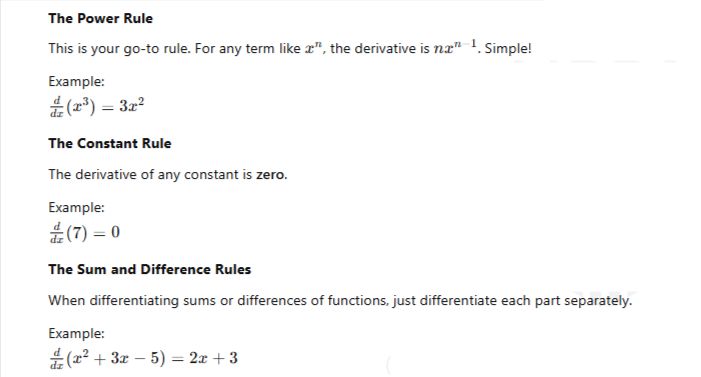
What is Differentiation? A-Level Calculus Basics Explained
What is Calculus?
Calculus is like the magic wand of mathematics. It helps us understand how things change. From the curve of a rollercoaster to the speed of a rocket, calculus explains the why and how of motion and change.
Two Main Branches: Differentiation and Integration
Think of calculus as having two sides: differentiation, which focuses on change, and integration, which looks at accumulation. This article focuses on the first differentiation.
Understanding the Concept of a Derivative
01. Rate of Change in Real Life
Ever checked how fast your car is going? That’s a real-life rate of change – speed is the rate at which distance changes over time. Differentiation helps you calculate such changes precisely.
02. The Tangent Line and Instantaneous Rate
Imagine a curve on a graph. Now imagine a line just touching that curve at a single point – that’s the tangent. The slope of that tangent gives you the instantaneous rate of change at that point. That slope is the derivative. Learn about What is a Sentence?
Why Differentiation Matters in A-Level Maths
01. Relevance to Real-World Applications
From physics and engineering to biology and finance, differentiation has practical uses everywhere. It helps model growth, decay, trends, and movement.
02. Connection to Other Areas of Maths and Science
Differentiation connects algebra, trigonometry, and geometry. It’s the glue that holds many advanced mathematical ideas together. A guide for What are Nouns, Verbs, and Adjectives
Basic Rules of Differentiation

Common Functions and Their Derivatives
Polynomial Functions: Polynomials are straightforward. Use the power rule.
The Chain Rule
Differentiating Composite Functions: When one function is inside another, the chain rule is your friend.
The Product Rule
When to Use It: When you’re multiplying two functions together.
The Quotient Rule
How It Works: Used when dividing one function by another.
Higher Order Derivatives
First, Second, and Third Derivatives
- First derivative: rate of change
- Second: rate of change of the rate (e.g. acceleration)
- Third: changes in acceleration (jerk in physics!)
Applications of Differentiation
- Optimisation Problems: Want to find the best value (maximum profit or minimum cost)? Differentiation helps.
- Motion and Physics: Speed, acceleration, force – all found using derivatives.
- Economics and Business: Used for marginal cost, revenue analysis, and more.
Common Mistakes and How to Avoid Them
- Misusing Rules: Mixing up the product and chain rule is common. Always identify the structure before applying a rule.
- Forgetting to Simplify: A messy final answer loses marks. Always simplify and check!
Conclusion
Differentiation is the heartbeat of calculus – how we measure change, find turning points, and make sense of the world’s curves and motions. Whether you’re solving classroom problems or real-world puzzles, mastering this skill will boost your confidence and scores in A-Level Maths. So take it one rule at a time, practise loads, and soon, you’ll be differentiating like a pro. Enrol now for affordable Online Tutoring UK
FAQs
1. What’s the easiest way to learn differentiation?
Start with the basic rules and practise simple problems. Visualise graphs and understand what derivatives represent.
2. Why is the derivative of a constant zero?
Because constants don’t change. Their rate of change – the derivative – is zero.
3. What is the difference between dy/dx and f'(x)?
They mean the same thing – the derivative of a function – just written differently.
4. Can differentiation be used in real life?
Absolutely! From calculating speed to maximising profits, it’s used in science, business, and engineering.
5. What are the most important rules to remember?
The power rule, chain rule, product rule, and quotient rule – learn these and you’re golden.
